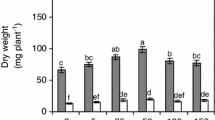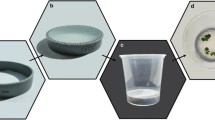Abstract
Key message
Poplar callus maintained a specific difference in osmotic potential with respect to media when supplemented with different carbohydrate concentrations. This balance in osmotic potential guaranteed the growth capacity.
Abstract
Osmotic stress is caused by several abiotic factors such as drought, salinity, or freezing. However, the threshold of osmotic potential that allows the growth under stress conditions has not been thoroughly studied. In this study, different levels of osmotic stress in Populus alba (L.) callus have been induced with the addition of mannitol or sorbitol in the medium (from 0 to 500 mM). The key factor for preserving the growth was observed to be the restoration of a constant difference in osmotic potential between callus and medium for all the tested conditions. The osmotic adjustments were primarily achieved with the uptake of mannitol or sorbitol from the media considering their chemical properties instead of their biological functions. The decrease in water content (from − 1 to − 10% after 21 days) and mineral elements, such as potassium, calcium, and magnesium, together with the alterations in cell morphology, did not show negative effects on growth. The activity of sorbitol dehydrogenase was detected for the first time in poplar (+ 4.7 U l−1 in callus treated with sorbitol compared to control callus). This finding suggested the importance of choosing carefully the molecules used to exert osmotic stress for separating the dual function of carbohydrates in osmotic adjustments and cell metabolism.







Similar content being viewed by others
References
Aazami MA, Torabi M, Jalili E (2010) In vitro response of promising tomato genotypes for tolerance to osmotic stress. Afr J Biotech 9(26):4014–4017
Abu-Romman S (2010) Responses of cucumber callus to sorbitol-induced osmotic stress. J Genet Eng Biotechnol 8(2):45–50
Adams HD, Germino MJ, Breshears DD, Barron-Gafford GA, Guardiola-Claramonte M, Zou CB, Huxman TE (2013) Nonstructural leaf carbohydrate dynamics of Pinus edulis during drought-induced tree mortality reveal role for carbon metabolism in mortality mechanism. New Phytol 197:1142–1151
Aguayo MF, Ampuero D, Mandujano P, Parada R, Muñoz R, Gallart M, Altabella T, Cabrera R, Stange C, Handford M (2013) Sorbitol dehydrogenase is a cytosolic protein required for sorbitol metabolism in Arabidopsis thaliana. Plant Sci 205:63–75
Ahmad MSA, Javed F, Ashraf M (2007) Iso-osmotic effect of NaCl and PEG on growth, cations and free proline accumulation in callus tissue of two indica rice (Oryza sativa L.) genotypes. Plant Growth Regul 53(1):53–63
Bae EK, Lee H, Lee JS, Noh EW (2010) Isolation and characterization of osmotic stress-induced genes in poplar cells by suppression subtractive hybridization and cDNA microarray analysis. Plant Physiol Biochem 48:136–141
Bajji M, Lutts S, Kinet JM (2000) Physiological changes after exposure to and recovery from polyethylene glycol-induced water deficit in callus cultures issued from durum wheat (Triticum durum Desf.) cultivars differing in drought resistance. J Plant Physiol 156:75–83
Bekheet SA (2015) Effect of drought stress induced by mannitol and polyethylene glycol on growth and silymarin content of Milk thistle callus cultures. World J Pharmaceut Res 4(8):116–127
Bellasio C, Fini A, Ferrini F (2014) Evaluation of a high throughput starch analysis optimised for wood. PLoS ONE 9(2):e86645
Blum A (2017) Osmotic adjustment is a prime drought stress adaptive engine in support of plant production. Plant Cell Environ 40(1):4–10
Büttner M (2007) The monosaccharide transporter (-like) gene family in Arabidopsis. FEBS Lett 581(12):2318–2324
Emiliani G, Traversari S, De Carlo A, Traversi ML, Cantini C, Giovannelli A (2016) B-type cyclin modulation in response to carbon balance in callus of Populus alba. Plant Cell, Tissue Organ Cult 124(2):283–293
Errabii T, Gandonou CB, Essalmani H, Abrini J, Idaomar M, Skali-Senhaji N (2006) Growth, proline and ion accumulation in sugarcane callus cultures under drought-induced osmotic stress and its subsequent relief. Afr J Biotech 5(16):1488–1493
Galvez DA, Landhäusser SM, Tyree MT (2011) Root carbon reserve dynamics in aspen seedlings: does simulated drought induce reserve limitation? Tree Physiol 31:250–257
Gucci R, Lombardini L, Tattini M (1997) Analysis of leaf water relations in leaves of two olive (Olea europaea) cultivars differing in tolerance to salinity. Tree Physiol 17:13–21
Guerriero G, Hausman JF, Cai G (2014) No stress! Relax! Mechanisms governing growth and shape in plant cells. Int J Mol Sci 15:5094–5114
Hare PD, Cress WA, Van Staden J (1998) Dissecting the roles of osmolyte accumulation during stress. Plant, Cell Environ 21(6):535–553
Hu L, Lu H, Liu Q, Chen X, Jiang X (2005) Overexpression of mtlD gene in transgenic Populus tomentosa improves salt tolerance through accumulation of mannitol. Tree Physiol 25(10):1273–1281
Jia Y, Wong DC, Sweetman C, Bruning JB, Ford CM (2015) New insights into the evolutionary history of plant sorbitol dehydrogenase. BMC Plant Biol 15(1):101
Kang JM, Kojima K, Ide Y, Sasaki S (1996) Growth response to the stress of low osmotic potential, salinity and high pH in cultured shoot of Chinese poplars. J For Res 1(1):27–29
Le Gall H, Philippe F, Domon JM, Gillet F, Pelloux J, Rayon C (2015) Cell wall metabolism in response to abiotic stress. Plants (Basel) 16:112–166
Lipavska H, Vreugdenhil D (1996) Uptake of mannitol from the media by in vitro grown plants. Plant Cell Tissue Organ Cult 45(2):103–107
Liu W, Fairbairn DJ, Reid RJ, Schachtman DP (2001) Characterization of two HKT1 homologues from Eucalyptus camaldulensis that display intrinsic osmosensing capability. Plant Physiol 127(1):283–294
Lutts S, Almansouri M, Kinet JM (2004) Salinity and water stress have contrasting effects on the relationship between growth and cell viability during and after stress exposure in durum wheat callus. Plant Sci 167:9–18
Lutts S, Kinet JM, Bouharmont J (1996) Effects of various salts and of mannitol on ion and proline accumulation in relation to osmotic adjustment in rice (Oryza sativa L.) callus cultures. J Plant Physiol 149:186–195
Murashige T, Skoog F (1962) A revised medium for rapid growth and bioassays with tobacco tissue cultures. Physiol Plant 15(3):473–497
Rhodes D, Samaras Y (1994) Genetic control of osmoregulation in plants. In: Strange K (ed) Cellular and molecular physiology of cell volume regulation. CRC press 416, Florida, USA
Sawwan J, Shibli RA, Swaidat I, Tahat M (2000) Phosphorus regulates osmotic potential and growth of African violet under in vitro-induced water deficit. J Plant Nutr 23(6):759–771
Sengupta S, Majumdar AL (2014) Physiological and genomic basis of mechanical-functional trade-off in plant vasculature. Front Plant Sci 28:224
Sevanto S, McDowell NG, Dickman LT, Pangle R, Pockman WT (2014) How do trees die? A test of the hydraulic failure and carbon starvation hypotheses. Plant Cell Environ 37:153–161
Shen B, Jensen RG, Bohnert HJ (1997) Mannitol protects against oxidation by hydroxyl radicals. Plant Physiol 115(2):527–532
Slewinski TL (2011) Diverse functional roles of monosaccharide transporters and their homologs in vascular plants: a physiological perspective. Molecular Plant 4(4):641–662
Spicer R (2014) Symplasmic networks in secondary vascular tissues: parenchyma distribution and activity supporting long-distance transport. J Exp Bot 65:1829–1848
Sun J, Li L, Liu M, Wang M, Ding M, Deng S, Lu C, Zhou X, Shen X, Chen ZX (2010) Hydrogen peroxide and nitric oxide mediate K+/Na+ homeostasis and antioxidant defense in NaCl-stressed callus cells of two contrasting poplars. Plant Cell Tissue Organ Cult 103(2):205–215
Tholakalabavi A, Zwiazek JJ, Thorpe TA (1994) Effect of mannitol and glucose-induced osmotic stress on growth, water relations, and solute composition of cell suspension cultures of poplar (Populus deltoides var. Occidentalis) in relation to anthocyanin accumulation. Vitro Cell Dev Biol Plant 30(3):164–170
Tholakalabavi A, Zwiazek JJ, Thorpe TA (1997) Osmotically-stressed poplar cell cultures: anthocyanin accumulation, deaminase activity, and solute composition. J Plant Physiol 151(4):489–496
Tsugama D, Liu S, Takano T (2012) A bZIP protein, VIP1, is a regulator of osmosensory signaling in Arabidopsis. Plant Physiol 159:144–155
Traversari S, Francini A, Traversi ML, Emiliani G, Sorce C, Sebastiani L, Giovannelli A (2018) Can sugar metabolism in the cambial region explain the water deficit tolerance in poplar? J Exp Bot 69:4083–4097
Traversari S, Neri A, Traversi ML, Giovannelli A, Francini A, Sebastiani L (2020) Daily osmotic adjustments in stem may be good predictors of water stress intensity in poplar. Plant Physiol Biochem 146:13–22
Trivedi S, Galiba G, Sankhla N, Erdei L (1991) Responses to osmotic and NaCl stress of wheat varieties differing in drought and salt tolerance in callus cultures. Plant Sci 73:227–232
Vitagliano C, Sebastiani L, Minnocci A (1999) Structural and microanalytical studies on frozen-hydrated tissues from different kiwifruit organs. Acta Hort 498:185–192
Von Aderkas P, Bonga JM (2000) Influencing micropropagation and somatic embryogenesis in mature trees by manipulation of phase change, stress and culture environment. Tree Physiol 20(14):921–928
Xiong L, Zhu JK (2002) Molecular and genetic aspects of plant responses to osmotic stress. Plant Cell Environ 25:131–139
Zwieniecki MA, Secchi F (2015) Threats to xylem hydraulic function of trees under ‘new climate normal’ conditions. Plant Cell Environ 38:1713–1724
Acknowledgements
Financial support was provided by Agrobioscience PhD program at Scuola Superiore Sant’Anna of Pisa to ST and by MIUR (Progetto Premiale 2012 “Aqua”) and Regione Toscana (POR CRO FSE 2012-2014, research project “Sysbiofor”) to AG.
Author information
Authors and Affiliations
Corresponding author
Ethics declarations
Conflict of interest
The authors declare that they have no conflict of interest.
Additional information
Communicated by Günther Hahne.
Publisher's Note
Springer Nature remains neutral with regard to jurisdictional claims in published maps and institutional affiliations.
Electronic supplementary material
Below is the link to the electronic supplementary material.
Rights and permissions
About this article
Cite this article
Traversari, S., De Carlo, A., Traversi, M.L. et al. Osmotic adjustments support growth of poplar cultured cells under high concentrations of carbohydrates. Plant Cell Rep 39, 971–982 (2020). https://doi.org/10.1007/s00299-020-02542-y
Received:
Accepted:
Published:
Issue Date:
DOI: https://doi.org/10.1007/s00299-020-02542-y




